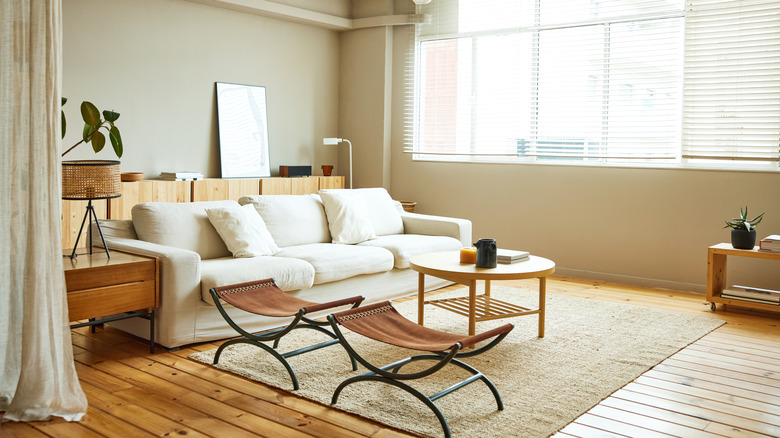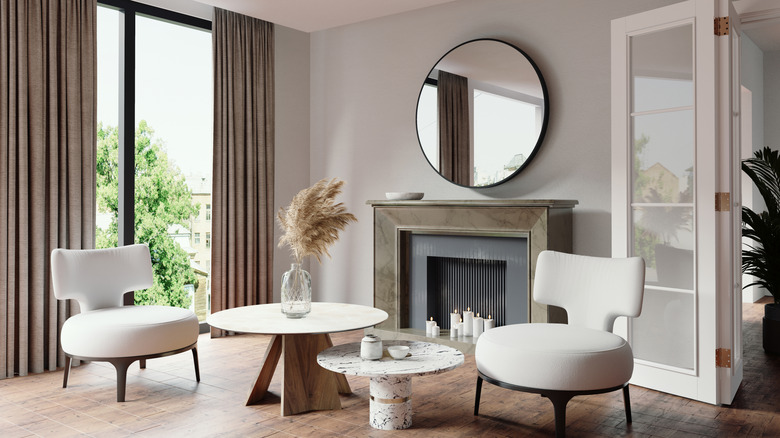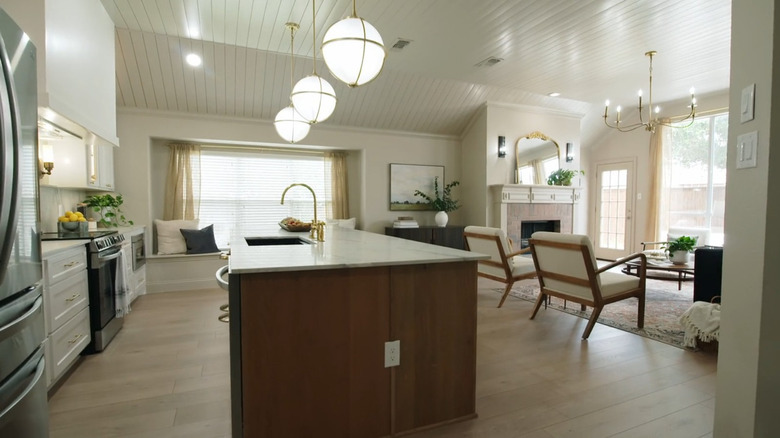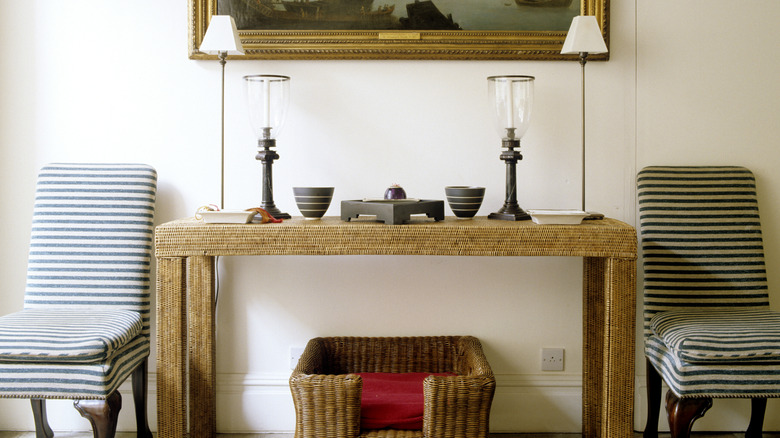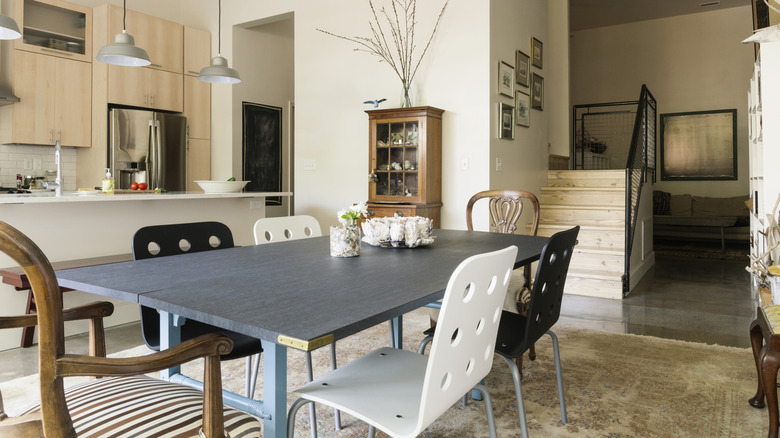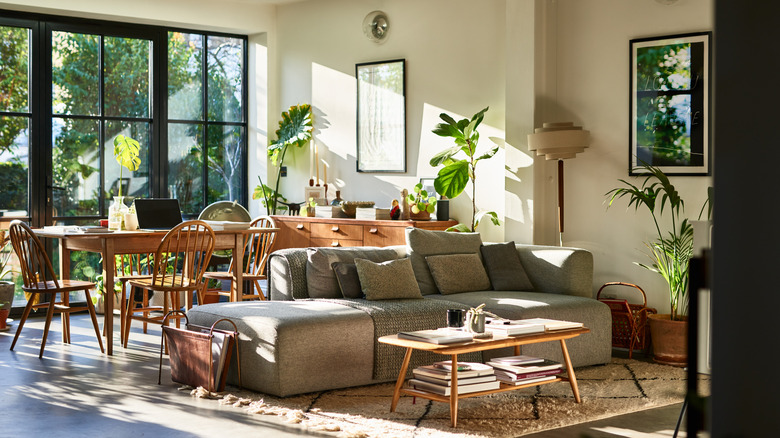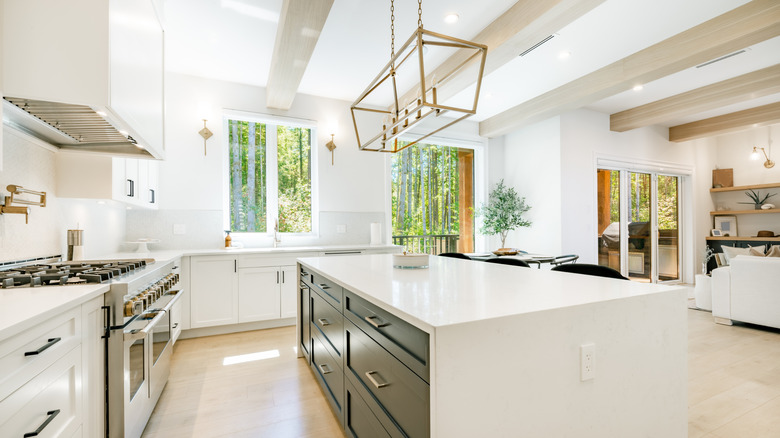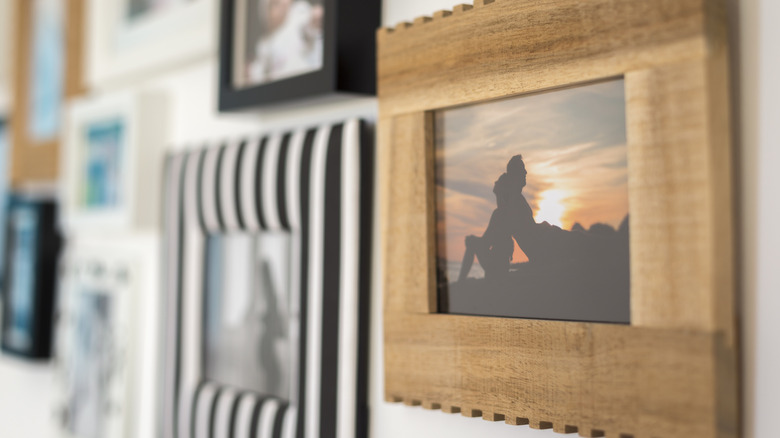10 Home Decorating Hacks HGTV Stars Use To Transform A Room In A Flash
While professional designers usually have weeks if not months to plan a project and source furniture, HGTV stars are pros at working under a time crunch. They often flip entire houses in a matter of weeks, days, or even hours, so they know how to transform a room in a flash. Sometimes, just a few strategic adjustments can completely refresh a space. These smart pivots don't just help them win competitions or impress clients — they're also great strategies for fans to copy at home.
When we're looking to update our own spaces, it's rare that we want to gut an entire room and start from scratch. Instead, we often want to do some fast tweaks that will make the space feel more modern and designer, or less dated and wonky. Whether that's breaking up matching furniture sets or reinstalling the window treatments at a higher height, here are some of the quickest hacks that HGTV stars have up their sleeves.
Joanna Gaines knows that a great rug can set the stage for the room
A rug can make or break a room, and Joanna Gaines knows this. If you choose just the right color, texture, and design, it can help bring out details in the room that previously went unnoticed. That's because its accent colors can pull out other hues scattered across the decor, and its design can help cinch a theme. It does way more than just add a soft place for your feet to land. "A good rug will ground the space, and that's where you can bring in more color," Gaines told Country Living. "A rug sets that stage for everything else that you layer on top of it." And since you only need to swap out one item to completely change how the space looks, you'll transform the room in a flash.
However, choosing one can feel tricky. There are tens of thousands of different designs to consider, and narrowing them down can often feel overwhelming. To do so, first nail down the look. Do you want your rug to be one solid color, a textured fiber, or patterned? A solid color one, like the Jonathan Tassel Rug, is great for maximalist spaces that already have a lot of patterns, textures, and a bevy of knick-knacks competing for attention. However, a textured fiber like jute, shag, or wool can help infuse a minimalist or neutral space with some dimension, making it appear not only a little more styled but also welcoming. For example, a textured option like the Hauteloom Grass Bleached Jute Rug can instantly add dimension to the room. Or, if you think the space needs a little more personality, then a patterned piece like an Oriental rug is a great way to go.
Next, focus on choosing the right size rug for your space. It should be large enough that at least the front legs of your furniture can anchor the rug. You also want it to be small enough to leave about 10-18 inches between it and the wall.
Ty Pennington quickly adds drama by incorporating tall decor pieces
Do you love the decor in your room, but something feels flat? You might need to take a page out of Ty Pennington's book and double-check if there is enough height variation in your design. "Add drama by interspersing the horizontal lines created by sofas and chairs with tall pieces," he told House Beautiful. "Floor lamps, high-based chairs, tall bookcases, or an urn filled with long, willowy branches are ideal to help with this."
Adding a tall plant or leaning a large mirror against a sideboard can instantly make the space feel more dynamic because more areas of the room are in use. The bottom half might be filled with furniture, rugs, and knick-knacks, but if the top half is bare, it will feel unfinished. But that doesn't mean you have to hang a bunch of paintings or frames. Instead, just like Pennington recommended, add various furniture and decor pieces with scaling heights.
For instance, you can lean an attention-grabbing floor mirror such as the Casolly Gold Antique Arched Mirror against the wall. Or, if you have several windows in the space, try hanging boldly patterned or colorful drapes, which will command attention. This will help move the eye around the room, making it feel more layered and designed.
Jenn Todryk quickly unifies a disjointed open floor plan with matching curtains
While open spaces are the epitome of having a modern, contemporary home, there are several reasons why you might want to avoid an open floor plan. And one of the biggest ones is that they're a challenge to style. Since there aren't walls separating the spaces, you need each "room" to flow into the other, each holding a common theme and design in order to look cohesive. However, this can be harder to pull off than it sounds. While most people tend to stick to a certain color palette to achieve this, it still might not be enough to make the space look unified.
However, Jenn Todryk has an easy decor trick for unifying an open-concept space, and that's using matching curtains. She used this trick in Season 3, Episode 7 of "No Demo Reno," helping to link a kitchen that flowed into a living room right across from it. "It's perfectly framed by these sheer curtains that I also used in the kitchen," Todryk said in the episode, referencing the large sliding doors in the living room. "It really helps unify these two spaces."
The eye will register the exact same detail, and even though it's in two separate "rooms", it will assume they're linked since it's the same fabric. And since all it takes is matching drapes, you just need to buy double the panels and you're done. However, just because you need the same style doesn't mean you need the same length. Not all windows are the same, so make sure you get sets that best fit those particular sizes. For instance, the Pitalk Natural Linen Curtains are available in lengths spanning 45 inches to 144 inches, allowing you to get the same product across multiple units.
Nate Berkus adds vintage pieces to instantly make the room feel more collected
Does your room feel like it's missing something? If it feels one-dimensional or flat, it might be because you relied too heavily on mass-produced pieces or matching sets. While they can be stylish, they don't really make a room feel "designed" since they tend to look overly familiar, don't have much craftsmanship, and usually focus on function over aesthetics. However, if you've fallen into the trap of buying too many safe furniture pieces, you don't necessarily have to scrap the entire design. Instead, use Nate Berkus's design hack and add a couple of vintage pieces to instantly make the room feel more curated. Rather than looking like you got all of your furniture from one big box store, the space will look like you carefully pieced it together, hunting for just the right elements. "Mix old pieces in with new ones," he advised on MyDomaine. "Vintage finds have a patina that makes a room look collected and assembled over time."
The beauty of this is that you just need a few vintage pieces in order to quickly turn things around. Add a weathered wooden chair to a corner, or disperse vintage pottery across your open shelving. Don't be afraid to add unlacquered brass elements that will carry a multi-colored patina or an Oriental rug that looks threadbare in certain spots. While they won't look new, their rough state will help balance out the showroom-like pieces in your room, creating a balance between the two elements.
Jeremiah Brent breaks up furniture sets to make cookie-cutter rooms feel more curated
Many of us default to buying matching furniture sets because they feel foolproof. You know the pieces will match, which makes it seem like the space will instantly feel cohesive and pulled together. However, what often happens is that the room looks one-dimensional and without personality. Matching furniture sets are going out of style because it seems like you had the entire space FedExed directly to your door, which takes the creativity and art out of interior design.
But that doesn't mean you should sell the set and accept the sting to your budget. Instead, Jeremiah Brent has a fast way to remedy the mistake, and that's to simply break up the set across multiple rooms. "When furniture isn't a full set, it inherently feels like you have been collecting items for years," he told MyDomaine. "Explore and experiment — even if you do happen to buy a full furniture set, spread the pieces among different rooms, and mix with different accessories." As long as the pieces aren't sitting next to each other in one space, they will look attractive and collected.
However, that might mean having to get creative with where each piece goes. If you're breaking up a bedroom set, you can transform the dresser into a dining room sideboard, placing it across from your table and using the drawers to stash things like tablecloths, linen napkins, and your collection of napkin rings. You can also transform the nightstand into a living room accent table by simply placing a vintage lamp on top of it. Have fun with the reconfiguring and allow yourself to get creative with the placements. It will make the room feel more interesting in the end.
Tiffany Brooks adds trees to quickly add a pop of color
Most people love to create timeless, neutral rooms — but sometimes that can be taken to the extreme, and the space ends up looking too monotone. If you're not one to add splashes of color just to break up the space — or are scared to try — then use Tiffany Brooks' easy hack. You can instantly add more color to a one-dimensional room with the help of trees. "You can add the color green with big trees and plants. [It's] one of my favorite tricks," Brooks shared on TikTok. "All the rooms I do always have a big tree or a big plant in it. It adds non-permanent color."
The key is to choose a large plant so it adds a good amount of green to the space. If you're really devoted to neutrals, select a tree that has muted green leaves, such as an olive tree. The Artificial Olive Tree by CapHaus, which stands 7 feet tall and has powdery sage green leaves, is a great pick if you don't have a green thumb. However, if you want to try some natural plants, you can also incorporate a fiddle leaf fig, which can grow to 10 feet tall; Madagascar Dragon Tree Dracaena, which can grow up to 6 feet tall and adds a sculptural effect with its spiky leaves; or rubber plants, which can grow up to 10 feet tall and have a bevy of different color varieties.
Erin Napier instantly improves ambiance with layered lighting
Decorating a room isn't just about making it aesthetically pleasing — it's also about creating a mood. A beautifully designed space feels welcoming and inviting, making you want to spend time inside it. And there is no faster way to help create that kind of ambiance than with lighting. When a room feels dull, Erin Napier likes to quickly increase the atmosphere by layering lighting. "I think light fixtures can be like a piece of art when they're off, but they need to give you appropriate light when they're on. They should always add warmth and improve the ambiance," she told Southern Living. "Layering with lamps is key!" It's not enough to just have one central ambient light, also known as "the big light." To set the mood, you also need enough task and accent lighting dispersed across the space in the form of sconces, table lamps, and floor lamps.
However, where do you decide to stage these lights? When it comes to task lighting, add a lamp in spaces where you plan to do some kind of activity. For instance, add a floor lamp right next to a reading chair, a table lamp on either side of the couch, and small lamps on tables or desks that you use for work, crafting, or building puzzles. As for accent lighting, look around the space and see what you want to bring attention to and highlight. Add lighting over your bookcases or floating shelves to drag the eye to their carefully curated vignettes, or hang picture lights over paintings or framed family photos. Or for a custom look, install sconces on either side of a prized credenza or to highlight a statement wall, like one paneled with wood.
Erin Napier also scales up light fixtures to make a room feel more impressive
If you have plenty of light and atmosphere in your room but none of the fixtures feel very design-worthy, then Erin Napier has an easy hack on how to make your pendants and sconces feel less drab and more designer — simply scale them up in size. "I think oversized is always better than undersized," she told Southern Living. "A light that's bigger is so much better than a light that's too small." Just swap out your pendant light for something twice as big, and you will instantly feel like an interior designer pieced your room together.
However, most of us play it safe with the sizing because we're nervous that it will end up looking comically big in the room. But Napier thinks we should ignore that urge because the opposite is often true. "It happens all the time and we think it's going to feel good in the room and then [the fixture] comes and it feels too small in the space, so don't be afraid to oversize," she says. "If you think it's a little too big, it's probably just right!"
To figure out the correct size, she recommends looking at the proportions present in the room. "Really get an understanding of the measurements before you select a piece. Think about the size of the room, your table, and any other factors," she recommended. One rule of thumb is to add the width and length of your room, and then get a lamp that is the same size but in inches. For example, if your living room is 12 feet wide and 14 feet long, you will need a lamp that is 26 inches wide. When in doubt, add an extra couple of inches to really make it a statement piece.
Jenny Marrs quickly transforms impersonal rooms with sentimental touches
If your room feels like a showroom and you're not sure why, it might be because there are no personal touches in it. Sometimes we get so wrapped up in creating an Instagram-worthy room that we exclude anything that doesn't fit that particular blueprint, including old knick-knacks, travel mementos, cheerful photos, and items that remind us of certain moments from the past. These things can often look kitschy, throwing off the "aesthetic." However, Jenny Marrs believes that the quickest way to infuse a room with personality and life is to add a few of these into the design. After all, a well-designed room lets visitors know exactly who you are the moment they step in. "I believe your home should be a reflection of who you are. This is why it's important for Dave and I to create custom pieces and incorporate personalized design elements into all of the work we do," she explained on her blog.
As an example, she noted the touches they added to the Brewer house in Season 2 of "Fixer to Fabulous." "I framed family memorabilia, including a photo of Doug's father, a hand-drawn survey of the property, an article with a headline from D-Day (his grandfather was a veteran of World War II), and old electrical and plumbing bills his grandparents had saved." When a person stepped into that living room, they got a sense of who that family was and where they came from. And since these pieces were tastefully framed and arranged as a gallery wall, they also blended in seamlessly with the room's design.
Bobby Berk quickly makes rooms feel more designer by hanging curtains higher and wider than the actual window frames
One of the biggest design faux pas you can make is hanging your curtain rod too low. When you place it directly over the window frame, it visually cuts the room at that height, oftentimes making it appear smaller than it is. Luckily, Bobby Berk has a quick solution for that: simply hang it higher to draw the eye upward and make the space feel more luxurious. "Unless you have extremely high ceilings, draperies should be hung as high as possible, wider than your window, and extend to the floor, just grazing the surface. This will create the illusion of a taller room, a wider window, and extend the lines of the space," he noted on his website. You can instantly transform the look of the space in the 10 minutes it takes to raise your rods a foot or two.
Just how high should you hang your curtains? There are a few formulas that will help you pinpoint the best placement for your particular room. The typical rule of thumb is to hang it halfway or 2/3rds of the way to your ceiling, depending on how tall it is. This will create enough space between the window frame and rod, making the room feel more spacious. As for how long your rod should be, aim to have the rod sit 6 to 10 inches away from the frame on either side. This will make your window look wider than it is and not overly obstruct your view.

